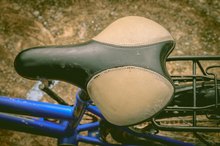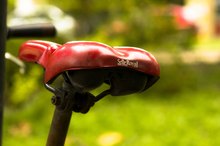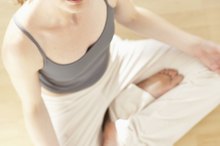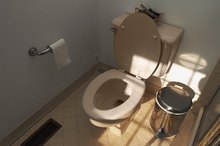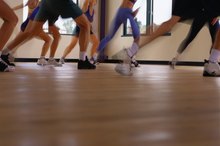What does fact checked mean?
At Healthfully, we strive to deliver objective content that is accurate and up-to-date. Our team periodically reviews articles in order to ensure content quality. The sources cited below consist of evidence from peer-reviewed journals, prominent medical organizations, academic associations, and government data.
The information contained on this site is for informational purposes only, and should not be used as a substitute for the advice of a professional health care provider. Please check with the appropriate physician regarding health questions and concerns. Although we strive to deliver accurate and up-to-date information, no guarantee to that effect is made.
A Urinary Tract Infection and Bike Riding
Bicycle riding combines two key triggers of female urinary tract infections -- friction and bacteria. If you're a woman and an avid cyclist, understanding the mechanics of infection and taking the right precautions can minimize the chance you'll contract a UTI during during this physical activity. If you're a male cyclist, little if any evidence shows a direct link between bike riding and infections, but the mechanics of cycling can aggravate another condition with symptoms mimicking bladder infections.
If you are experiencing serious medical symptoms, seek emergency treatment immediately.
Mechanics of Infection
The area of a woman's body closest to the bicycle seat typically contains a multitude of bacteria. If you're a female cyclist, regular bike riding or health-club indoor-biking classes cause repeated friction in that region of your body. According to Maine-based Women to Women Health Care Center, such repeated movement potentially pushes bacteria into the urethra -- the tube that carries urine from your body. Once inside, the bacteria travel up the urinary tract, sometimes causing infection that reaches as far as the kidneys 1. Women remain at greater risk for such infections than men, according to Mayo Clinic.
- The area of a woman's body closest to the bicycle seat typically contains a multitude of bacteria.
- According to Maine-based Women to Women Health Care Center, such repeated movement potentially pushes bacteria into the urethra -- the tube that carries urine from your body.
When to Seek Treatment
The Best Bike Seat for Males
Learn More
Common signs you're suffering a urinary tract infection requiring medical treatment include blood in urine, cloudy urine, strong urges to frequently urinate, pelvic pain in women and rectal pain in men, according to Mayo Clinic 1.cause:
- Common signs you're suffering a urinary tract infection requiring medical treatment include blood in urine
- cloudy urine
- strong urges to frequently urinate
- pelvic pain in women
- rectal pain in men
- according to Mayo Clinic 1
Urinary tract infections sometimes cause fevers, back or abdominal pain and pelvic pressure, Mayo notes 1.
Concerning Male Riders
The shape, friction and bounce of a bike seat sometimes aggravates the male prostate gland, located near the bladder. If you're a male rider already suffering from an enlarged prostate, frequent cycling often worsens the condition. And as prostates swell, they place pressure on the bladder, sometimes causing symptoms similar to urinary tract infections.
- The shape, friction and bounce of a bike seat sometimes aggravates the male prostate gland, located near the bladder.
- And as prostates swell, they place pressure on the bladder, sometimes causing symptoms similar to urinary tract infections.
Prevention Techniques
Causes of Prostate Pain When Sitting
Learn More
Padded cycling shorts, with gel, thick chamois or cloth reinforcement along the seat and crotch area, help minimize friction and bounce when riding. Proper seat adjustment and bike seats with coiled shocks beneath also provide some relief from friction and bounce. Women to Women Health Care Center recommends that female riders "flush out their systems at the earliest signs" of urinary tract infections, consuming plenty of water to induce more frequent urination. Urinating immediately after periods of prolonged friction in the vaginal area -- such as following long bike rides -- also mitigates infection, according to Women to Women.
- Padded cycling shorts, with gel, thick chamois or cloth reinforcement along the seat and crotch area, help minimize friction and bounce when riding.
Common Treatments
Women to Women notes urinary tract infections require treatment with antibiotics. But the clinic recommends incorporating preventive techniques, particularly if you're prone to frequent urinary tract infections 1. Repeated cycles of antibiotics for treatment increases the odds of additional infection, your body's resistance to antibiotics and the likelihood of suffering a yeast infection if you're a female, according to the center.
Related Articles
References
- Mayo Clinic: Urinary Tract Infection
- Bike Route.com: Medical Benefits of Recumbent Bicycles
- Al-badr A, Al-shaikh G. Recurrent Urinary Tract Infections Management in Women: A review. Sultan Qaboos Univ Med J. 2013;13(3):359-67.
- Harvard Health Publishing. Urinary Tract Infection in Women. Harvard Health. May 2017.
- Harvard Health Publishing. Urinary Tract Infection in Men. Harvard Health. Mar 2019.
- Hayashi Y, Kohri K. Circumcision related to urinary tract infections, sexually transmitted infections, human immunodeficiency virus infections, and penile and cervical cancer. Int J Urol. 2013;20(8):769-75. doi:10.1111/iju.12154
- Symptoms & Causes of Bladder Control Problems & Bedwetting in Children. National Institute of Diabetes and Digestive and Kidney Diseases.Sept 1, 2017.
- Choose Water as a Drink. Healthy Kids, NSW Ministry of Health.
- Al-Badr. and Al-Shaikh, B. "Recurrent Urinary Tract Infections Management in Women: A Review." Sultan Qaboos Univ Med J. 2013: 359-67.
- Badran, Y.; El-Kashef, T.; and Abdelaziz, A. "Impact of genital hygiene and sexual activity on urinary tract infection during pregnancy." Urol Ann. 2015; 7(4):478-81. DOI: 10.4103/0974-7796.157971.
- Solomon, C. "Urinary Tract Infections in Older Men." N Engl J Med. 2016; 374:562-571. DOI: 10.1056/NEJMcp1503950.
Writer Bio
Marc Chase is a veteran investigative newspaper reporter and editor of 12 years. Specializing in computer-assisted reporting, he holds a Bachelor of Science in journalism from Southern Illinois University and a Master of Arts in public affairs reporting from the University of Illinois.
